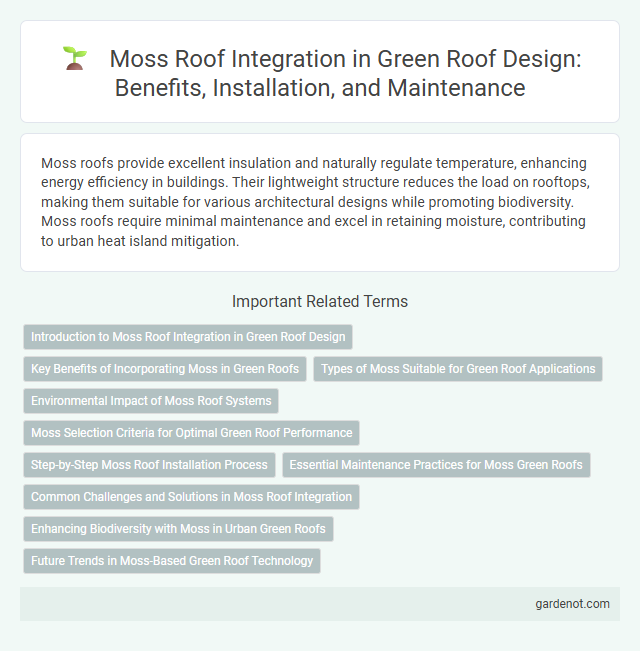Moss roofs provide excellent insulation and naturally regulate temperature, enhancing energy efficiency in buildings. Their lightweight structure reduces the load on rooftops, making them suitable for various architectural designs while promoting biodiversity. Moss roofs require minimal maintenance and excel in retaining moisture, contributing to urban heat island mitigation.
Introduction to Moss Roof Integration in Green Roof Design
Moss roofs offer a sustainable alternative in green roof design by providing lightweight, low-maintenance vegetation that thrives in shaded or damp environments. Their ability to retain moisture and improve insulation enhances energy efficiency while contributing to urban biodiversity. Integrating moss roofs into green infrastructure supports stormwater management and reduces the urban heat island effect.
Key Benefits of Incorporating Moss in Green Roofs
Incorporating moss in green roofs enhances water retention, reducing stormwater runoff and mitigating urban heat island effects. Moss improves insulation, lowering energy costs by regulating building temperatures naturally. Its low maintenance and resilience to harsh conditions make moss a sustainable, eco-friendly choice for green roof systems.
Types of Moss Suitable for Green Roof Applications
Sheet moss (Hypnum spp.) and cushion moss (Leucobryum glaucum) are commonly used in green roof applications due to their low maintenance and drought tolerance. Polytrichum moss offers excellent water retention and insulative properties, making it ideal for cooler climates. Sphagnum moss is valued for its high moisture retention, supporting plant growth and enhancing substrate stability on green roofs.
Environmental Impact of Moss Roof Systems
Moss roof systems provide significant environmental benefits by improving air quality through natural carbon sequestration and reducing urban heat island effects due to their high albedo and evapotranspiration rates. These roofs enhance biodiversity by creating habitats for microorganisms and insects, contributing to urban ecological networks. Furthermore, moss roofs effectively manage stormwater by retaining and slowly releasing precipitation, thereby reducing runoff and mitigating flood risks.
Moss Selection Criteria for Optimal Green Roof Performance
Moss selection for green roofs requires evaluating species for drought tolerance, shade adaptability, and substrate compatibility to ensure resilience in varying microclimates. Opting for native mosses with low nutrient demands and high water retention capabilities promotes sustainable growth and reduces maintenance needs. Proper moss selection enhances thermal insulation, stormwater management, and overall biodiversity on green roofs.
Step-by-Step Moss Roof Installation Process
Moss roof installation begins with selecting a suitable substrate, such as a moisture-retentive base like coconut coir or specialized moss mats, ensuring proper surface preparation for optimal growth. The next step involves carefully spreading live moss fragments or a moss slurry evenly across the surface, maintaining adequate moisture levels to promote establishment. Regular watering and minimal foot traffic facilitate moss rooting and spreading, ultimately creating a low-maintenance, eco-friendly green roof that enhances insulation and biodiversity.
Essential Maintenance Practices for Moss Green Roofs
Moss green roofs require consistent moisture monitoring to maintain optimal hydration levels, as moss thrives in damp environments and can suffer from drying out in hot, dry conditions. Regular debris removal prevents the accumulation of organic matter that could smother moss and promote unwanted plant growth, ensuring a healthy moss mat. Periodic inspection for pests and diseases, combined with gentle trimming of overgrown moss patches, supports the long-term vitality and aesthetic appeal of the moss green roof system.
Common Challenges and Solutions in Moss Roof Integration
Moss roofs commonly face challenges such as moisture retention leading to potential structural damage, limited growth in dry or highly shaded areas, and vulnerability to pests and diseases. Effective solutions include proper substrate selection to enhance drainage, regular maintenance to manage moss health, and strategic placement ensuring optimal light and moisture conditions. Incorporating a well-designed irrigation system and using native moss species adapted to local climate can significantly improve the longevity and performance of moss roofs.
Enhancing Biodiversity with Moss in Urban Green Roofs
Moss roofs significantly enhance biodiversity in urban green roofs by providing a unique microhabitat that supports a diverse range of invertebrates and microorganisms. The dense, moisture-retentive structure of mosses improves urban ecosystem health by promoting native species and mitigating heat island effects. Incorporating moss into green roofs increases ecological resilience and contributes to sustainable urban biodiversity conservation.
Future Trends in Moss-Based Green Roof Technology
Moss-based green roof technology is advancing through innovations in drought-resistant moss species and lightweight substrate composites, enhancing sustainability and structural load efficiency. Integration of smart irrigation systems and bio-monitoring sensors enables real-time moisture and nutrient management, optimizing moss health and longevity. Future trends emphasize eco-friendly materials and automated maintenance to reduce urban heat islands and improve biodiversity in metropolitan areas.
Moss roof Infographic

 gardenot.com
gardenot.com